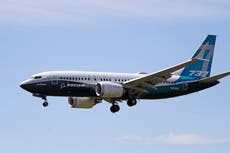Boeing 737 Max cleared to fly passengers again after deadly crashes
Returning jet to service will prove massive operation, after two deadly crashes
The Boeing 737 Max has been cleared to fly passengers again in the US, after two crashes led to the deaths of nearly 350 people.
On 29 October 2018, a single faulty sensor triggered an anti-stall system that caused Lion Air flight 610 to crash shortly after take off from Jakarta. All 189 passengers and crew died.
Less than six months later, Ethiopian Airlines flight 302 from Addis Ababa to Nairobi was lost, along with 157 lives, in similar circumstances.
In the immediate aftermath of the second fatal crash, the Federal Aviation Administration (FAA) continued to insist the jet was safe. But after every other major safety authority worldwide grounded the plane, the American regulator followed suit.
After a rigorous redesign and certification, the Boeing 737 Max is likely to be flying passengers again in the US before the end of 2020.
The FAA administrator, Steve Dickson, rescinded the order that grounded the aircraft. Simultaneously the authority published an Airworthiness Directive specifying design changes that must be made before the aircraft returns to service. The FAA has also specified new pilot training requirements.
“These actions do not allow the Max to return immediately to the skies,” the authority’s statement read.
“The FAA must approve 737 Max pilot training programme revisions for each US airline operating the Max and will retain its authority to issue airworthiness certificates and export certificates of airworthiness for all new 737 Max aircraft manufactured since the FAA issued the grounding order.
“Furthermore, airlines that have parked their Max aircraft must take required maintenance steps to prepare them to fly again.
“Following the return to service, the FAA will continue to work closely with our foreign civil aviation partners to evaluate any potential additional enhancements for the aircraft.”
Boeing’s chief executive, David Calhoun, said: “We will never forget the lives lost in the two tragic accidents that led to the decision to suspend operations.
“These events and the lessons we have learned as a result have reshaped our company and further focused our attention on our core values of safety, quality and integrity.”
The manufacturer has been repeatedly criticised for failings and shortcuts during the design process of the Max. Boeing now says: “The company is identifying, diagnosing and resolving issues with a higher level of transparency and immediacy.”
The FAA announcement applies only to US airlines.
The UK Civil Aviation Authority (CAA) and European Union Air Safety Agency (EASA) are unlikely to clear the plane for passenger service until the start 2021. Other countries are also being cautious.
Marc Garneau, the Canadian transport minister, said: “There will be differences between what the FAA has approved today, and what Canada will require for its operators.
“These differences will include additional procedures on the flight deck and pre-flight, as well as differences in training.
“The commercial flight restrictions for the operation of the Boeing 737 Max aircraft in Canadian airspace remain in effect and will not be lifted until the department is fully satisfied that all its safety concerns have been addressed, and that enhanced flight crew procedures and training are in place in Canada.”
American Airlines is already selling flights on the Boeing 737 Max, departing from New York’s La Guardia airport to Miami on 29 December.
But the families of some of the victims remain concerned that the data supporting the assertion that the Max 8 is now safe to fly has not been released, leaving “unanswered questions”.
Clive Garner, one of the aviation law specialists at Irwin Mitchell representing the families involved, said: “The root of the problem is that the Boeing 737 Max aircraft will remain aerodynamically unstable. It will still have a tendency for the nose to pitch during certain manoeuvres and in turn this could still lead to an increased risk of its engines stalling.
“It is deeply disappointing that the carefully considered and wholly reasonable requests of our clients have not been acted upon by the US authorities. We hope that EASA will take a different and more considered approach when they finally decide about whether the aircraft is safe to return to service in Europe.”
Join our commenting forum
Join thought-provoking conversations, follow other Independent readers and see their replies
Comments



Bookmark popover
Removed from bookmarks